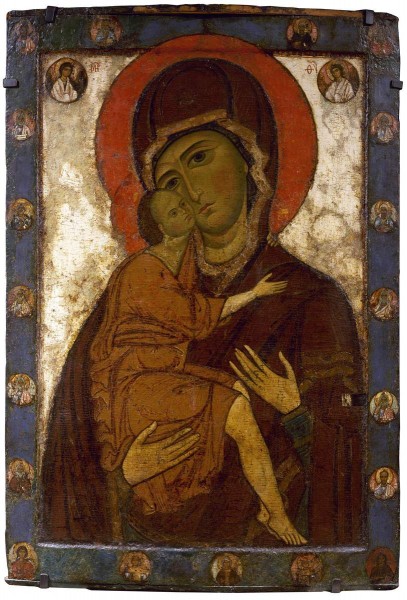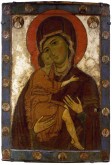The Mother of God of Tenderness of the White Lake
First half of the 13th century
- tempera and gesso on wood. 156 х 107 х 2
- ДРЖ-2116
Пост. из Спасо-Преображенского собора в г. Белозерске (Вологодская обл.)- Происходит из Спасо-Преображенского собора в Белозерске; ранее – в церкви Василия Великого в Белозерске
- Period Old Russian Art
- CategoryBiblical Subject
- Share
The icon is based on the compositional scene of Tenderness (Greek: Eleusa), depicting the Virgin and Child with their cheeks pressed together. This particular work is one of the most famous surviving images of the Theotokos from the Old Russian period. The halflength figure of the Virgin Mary is monumental and majestic. Her enormous eyes are full of sorrow, while her countenance is turned towards Jesus. The laconic and distinct outline of the Mother of God is likened to the silhouette of a church, while the head in the dark cherry-red veil recalls a cupola.
The body of Christ Emmanuel does not extend beyond the bounds of the figure of the Virgin. The cheek of the Child brushes against His mother’s face and their haloes merge, symbolising their unbreakable unity. Christ sits on the right hand of Mary, who is worshipped by the angels with covered arms in the round medallions in the top corners. The movement of the Virgin’s hands forms a cross, while the gestures of Christ are also crossshaped.
The large image of the Infant in comparison to the Mother of God is a specific feature of the iconography of Christ Emmanuel. Jesus is dressed in a short, ochre-coloured tunic, revealing the immaculate flesh of the Child and conjuring up associations with the Eucharist sacrifice or sacrificial lamb. The entire image thus represents the incarnation of the Word inside the church of God and Jesus’ eternal, redemptive sacrifice. Russian Museum: From Icons to the Modern Times. Palace Editions, St Petersburg, 2015. P. 42.

